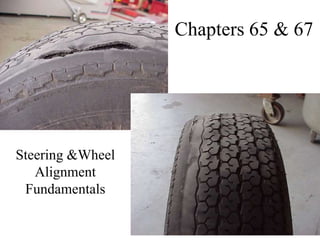Alignment Angles.ppt
•Download as PPT, PDF•
0 likes•20 views
Wheel alignment
Report
Share
Report
Share

More Related Content
Similar to Alignment Angles.ppt
Similar to Alignment Angles.ppt (20)
Unit 2 Front and Rear Axles, Steering Sysytem, Wheels and Tyres

Unit 2 Front and Rear Axles, Steering Sysytem, Wheels and Tyres
Presentation on Steering pull on vehicle by Yogesh prasad

Presentation on Steering pull on vehicle by Yogesh prasad
More from Senthil Kumar
More from Senthil Kumar (15)
Recently uploaded
(COD) ̄Young Call Girls In Dwarka , New Delhi꧁❤ 7042364481❤꧂ Escorts Service i...

(COD) ̄Young Call Girls In Dwarka , New Delhi꧁❤ 7042364481❤꧂ Escorts Service i...Hot Call Girls In Sector 58 (Noida)
Alina 7042364481 Call Girls Service Pochanpur Colony - independent Pochanpur ...

Alina 7042364481 Call Girls Service Pochanpur Colony - independent Pochanpur ...Hot Call Girls In Sector 58 (Noida)
Stay Cool and Compliant: Know Your Window Tint Laws Before You Tint

Stay Cool and Compliant: Know Your Window Tint Laws Before You TintBisnar Chase Personal Injury Attorneys
꧁ ୨⎯Call Girls In Ashok Vihar, New Delhi **✿❀7042364481❀✿**Escorts ServiCes C...

꧁ ୨⎯Call Girls In Ashok Vihar, New Delhi **✿❀7042364481❀✿**Escorts ServiCes C...Hot Call Girls In Sector 58 (Noida)
Recently uploaded (20)
83778-77756 ( HER.SELF ) Brings Call Girls In Laxmi Nagar

83778-77756 ( HER.SELF ) Brings Call Girls In Laxmi Nagar
Vip Hot Call Girls 🫤 Mahipalpur ➡️ 9711199171 ➡️ Delhi 🫦 Whatsapp Number

Vip Hot Call Girls 🫤 Mahipalpur ➡️ 9711199171 ➡️ Delhi 🫦 Whatsapp Number
(COD) ̄Young Call Girls In Dwarka , New Delhi꧁❤ 7042364481❤꧂ Escorts Service i...

(COD) ̄Young Call Girls In Dwarka , New Delhi꧁❤ 7042364481❤꧂ Escorts Service i...
Call Girls in Malviya Nagar Delhi 💯 Call Us 🔝9205541914 🔝( Delhi) Escorts Ser...

Call Girls in Malviya Nagar Delhi 💯 Call Us 🔝9205541914 🔝( Delhi) Escorts Ser...
Delhi Call Girls Mayur Vihar 9711199171 ☎✔👌✔ Whatsapp Hard And Sexy Vip Call

Delhi Call Girls Mayur Vihar 9711199171 ☎✔👌✔ Whatsapp Hard And Sexy Vip Call
Delhi Call Girls Saket 9711199171 ☎✔👌✔ Whatsapp Hard And Sexy Vip Call

Delhi Call Girls Saket 9711199171 ☎✔👌✔ Whatsapp Hard And Sexy Vip Call
Alina 7042364481 Call Girls Service Pochanpur Colony - independent Pochanpur ...

Alina 7042364481 Call Girls Service Pochanpur Colony - independent Pochanpur ...
Call Girls in Malviya Nagar Delhi 💯 Call Us 🔝9205541914 🔝( Delhi) Escorts Ser...

Call Girls in Malviya Nagar Delhi 💯 Call Us 🔝9205541914 🔝( Delhi) Escorts Ser...
9990611130 Find & Book Russian Call Girls In Vijay Nagar

9990611130 Find & Book Russian Call Girls In Vijay Nagar
Delhi Call Girls East Of Kailash 9711199171 ☎✔👌✔ Whatsapp Hard And Sexy Vip Call

Delhi Call Girls East Of Kailash 9711199171 ☎✔👌✔ Whatsapp Hard And Sexy Vip Call
Why Won't Your Subaru Key Come Out Of The Ignition Find Out Here!

Why Won't Your Subaru Key Come Out Of The Ignition Find Out Here!
Stay Cool and Compliant: Know Your Window Tint Laws Before You Tint

Stay Cool and Compliant: Know Your Window Tint Laws Before You Tint
How To Fix Mercedes Benz Anti-Theft Protection Activation Issue

How To Fix Mercedes Benz Anti-Theft Protection Activation Issue
꧁ ୨⎯Call Girls In Ashok Vihar, New Delhi **✿❀7042364481❀✿**Escorts ServiCes C...

꧁ ୨⎯Call Girls In Ashok Vihar, New Delhi **✿❀7042364481❀✿**Escorts ServiCes C...
Russian Call Girls Delhi Indirapuram {9711199171} Aarvi Gupta ✌️Independent ...

Russian Call Girls Delhi Indirapuram {9711199171} Aarvi Gupta ✌️Independent ...
Lucknow 💋 (Genuine) Escort Service Lucknow | Service-oriented sexy call girls...

Lucknow 💋 (Genuine) Escort Service Lucknow | Service-oriented sexy call girls...
Alignment Angles.ppt
- 1. Chapters 65 & 67 Steering &Wheel Alignment Fundamentals
- 2. Introduction to Wheel Alignment • Toe • Camber • Caster • Steering Axis Inclination (SAI) • Turning Radius ALIGNMENT ANGLES
- 3. Toe is a comparison of the distances between the front and the rear of a pair of tires. (As seen from the top)
- 4. Camber is the inward or outward tilt of a tire as seen from the top. Camber is a tire wearing angle. Positive camber causes outside wear, negative causes inside wear. Camber is often times an adjustable angle.
- 5. Caster is the forward or rearward tilt of the spindle support arm. (As seen from the side) Caster is not a tire wearing angle. Caster is often times an adjustable angle. Unequal caster side to side will cause a steering “pull”.
- 7. Steering axis inclination (SAI), AKA as BJI or KPI, is an imaginary line drawn through the upper and lower pivot points. NOT ADJUSTABLE NOT A TIRE WEARING ANGLE DRIRECTIONAL CONTROL ANGLE: after a turn SAI helps return to wheels to straight ahead
- 8. Turning Radius, also known as toe out on turns, is the angle created by a common point to both front wheels.
- 9. Before proceeding with any adjustment to the alignment angles, the steering and suspension components must be checked for excessive wear.
- 10. Turning the tie rod adjusting sleeves that connect the inner and outer tie rods will change the toe angle.
- 11. Springs will get tired and sag over a period of time. This will also change alignment angles. The springs are responsible for correct ride height.
